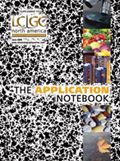New Innovations for EPA 8260 Analysis
Over the past 15 years, little has changed for the commercial environmental laboratory's ability to automate U.S. EPA Method 8260 for water and soil purge and trap analysis. As work loads have increased, reporting levels have decreased due to MS sensitivity improvements. However, it has become increasingly difficult for laboratories to run at high levels of productivity due to autosampler reliability, carryover, and internal standard reproducibility challenges. Each of these issues has been addressed in a new Centurion WS autosampler (see Figure 1) designed specifically for the commercial environmental laboratory.
EST Analytical
Over the past 15 years, little has changed for the commercial environmental laboratory's ability to automate U.S. EPA Method 8260 for water and soil purge and trap analysis. As work loads have increased, reporting levels have decreased due to MS sensitivity improvements. However, it has become increasingly difficult for laboratories to run at high levels of productivity due to autosampler reliability, carryover, and internal standard reproducibility challenges. Each of these issues has been addressed in a new Centurion WS autosampler (see Figure 1) designed specifically for the commercial environmental laboratory.

Figure 1
Reliability
In order to remain productive, systems must run 24 h a day. Lost vial errors, syringe errors, and elevator errors have plagued vial purge and trap autosamplers since their inception. In order to solve these problems a number of steps were taken to improve reliability. First, the autosampler was designed so only low level soil samples are moved by the autosampler, reducing ~80% of the vials that need to be transported to a processing station. Instead, a separate needle is moved to the water vial and a sample is withdrawn with the vial in place. Second, the system was designed without a syringe and instead uses a fixed volume loop. This enables very fast sampling without syringe errors and maintenance. All mechanical switches were eliminated from design consideration and more reliable optical sensors were used. The result is a more robust and reliable system.
Carryover
In many states, lower detection limits and higher molecular weight compounds are making carryover a larger concern than in years past. Historically, water rinses of the glassware have been the only solution to decrease carryover. Due to the syringe style design of previous autosamplers, this was a slow process so customers limited the number of rinses in order to improve sample throughput. With the new Centurion WS, users can rinse three times faster and can perform more rinses for improved carryover. In addition, coupled with specific purge and trap concentrators, the system can purge the entire soil sample pathway. Traditionally, only the sample needle was swept after a sample was analyzed.
Internal Standard
Since all analyses are based upon internal standard response, too much variability of internal standards can cause the system to be out of compliance and result in samples being re-run. Much of the internal standard variability in previous generation systems is due to the fact that the sample traveled through a fixed loop to pick up internal standard. Particulate in the sample can be left behind to score the valve rotor and change the volume of the internal standard being delivered. A new type valve which "spits" a programmed volume into the sample without the sample traveling through the valve eliminates this concern and results in a more robust, compliant system.
Conclusion
Sample throughput, meeting customers turnaround time expectations, carryover, and overall reliability have plagued the VOC analytical laboratory for decades. By dramatically decreasing the number of vials moved by the autosampler, improving carryover, improving reliability of the internal standard mechanism, and adding features that allow customers to process 100 samples in 24 h, (with dual concentrators installed), laboratories will see enhanced productivity and overall improved operations.

EST Analytical
503 Commercial Drive, Fairfield, OH 45014
tel. (800)283-3510, (513)642-0100, fax (513)642-0109
Email: est@estanalytical.com Website: www.estanalytical.com
